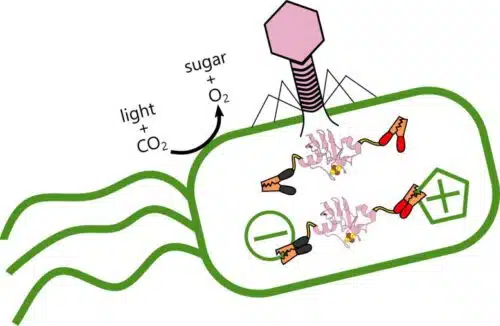Scientists at Rice University are investigating the role of FERREDOXIN proteins that are formed when viruses that attack bacteria disrupt the transfer of electrons in photosynthetic marine bacteria that produce oxygen and fix carbon. When the virus hits a bacterium, it creates a FERREDOXIN protein that binds to the bacterium's existing electrical structure and changes its metabolism.
By Rice University: Translated by Hannah Rosenfelder

Beneath the sea, one virus takes over the world's most common organism. This may interest us, as those who live and breathe oxygen above sea level. Rice University scientists investigated the role of FERREDOXIN proteins created when aggressive viruses change the ability of PROCHLOROCOCCUS MARINUS bacteria to fix carbon and eradicate the greenhouse effect that arises from the use of fossil fuel (fossil fuel).
P MARINU is an oxygen-creating, photosynthetic microorganism that is mostly found in tropical and subtropical regions, where about an octillion (10 to the 27th power) of them use sunlight to create oxygen and fix about 4 gigatons of carbon per year. Some of this carbon feeds other marine microorganisms.
But these aggressive viruses are not friendly. The virus uses the energy that the bacterium creates from sunlight, through reprogramming the bacterium's genome that causes a change in the way it transfers electrons.
"P MARINUS and its carbon fixation mechanisms are sensitive to temperature, and thus it is useful to monitor the changes following global warming, which will increase its living space," says Ian Campbell, a postdoctoral researcher at Rice University and lead author of the study, which was published in the JOURNAL OF BIOLOGICAL CHEMISTRY.
"The increase in the space of the micro-organism in the sea can increase the total carbon fixed by these bacteria", he said. Alternatively, the viruses that attack these bacteria may change their ability to fix carbon and may prevent the removal of gigatons of carbon from the air each year, according to a new estimate.
Campbell said the purpose of the study was to examine the variety of ways in which viruses interact with their hosts. During the research, the scientists discovered that the aggressive virus takes control over the passage of electrons from the bacterium, thereby rewiring the metabolism of the host bacterium. "When the virus infects the bacterium, it stops the production of the bacterium's proteins and replaces it with its own versions," he said. "I liken it to installing a new operating system on a computer."
The researchers used synthetic biology techniques to combine viruses and oxygen-generating proteins and learn how they interact. Part of the research, led by a biochemist from Rice University, George Phillips, determined for the first time the structure of the main FERREDOXIN protein.
"A normally lethal virus enters a cell and kills everything," said synthetic biologist Jonathan Silberg, the study's lead scientist and director of the university's Systems, Synthetic and Physical Biology program. "But Ian's results suggest that these deadly viruses produce a complex control mechanism," he said. “I wouldn't say they turned their hosts into zombies, since they let the cells run their own household. But they connect their FEEREDOXIN proteins, like power cables, to divert the flow of electrons.”
Instead of working directly with invasive viruses and the bacterium P. MARINUS, Campbell and his team used synthetic biology tools to program larger, more familiar E. Coli cells to express genes that mimic interactions between the two.
"Taking an aggressive virus and an oxygen-producing bacterium from the sea, and trying to study the biology, especially the transfer of electrons, are very complex tasks to perform using classical biochemistry," Silberg said. “Ian took pairs, both from the virus and the host, put them together by grafting their DNA into another cellular system, and produced interesting results quickly.
"It's an interesting application of synthetic biology to understand complex things that would be difficult to measure in other ways," he said.
The researchers hypothesize that the protein produced in the cells of the E. Coli, called Prochlorococcus P-SSM2 phage ferredoxin, is not a new organism. "People knew that viruses implanted different things that took over the transfer of electrons, but didn't know how to connect the cables between the attacker and the host," Silberg said. They also didn't know much about the evolution of the attacking virus. This step can be related to ancient proteins involved in photosynthesis."

2 תגובות
very ugly
"Power cables" are probably a translation of "Power Cable" which are electrical cables...